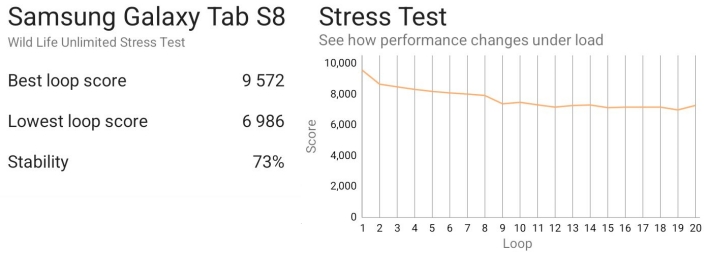Samsung Galaxy Tab S8 Review: Premium Android, S-Pen Prowess
Samsung Galaxy Tab S8 Review: Performance and Battery Life
Galaxy Tab S8 Geekbench Results
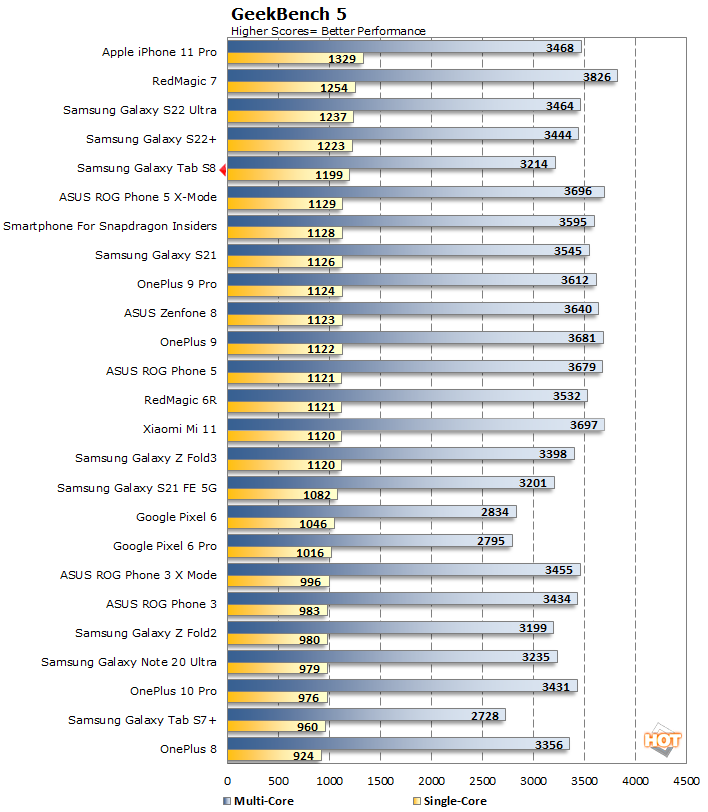
GeekBench isn't our favorite benchmark, as it's purely synthetic and can be heavily targeted for optimization. Regardless, the Snapdragon 8 Gen 1 processor delivers a slight improvement in single thread performance, but minimal improvement in multi-threaded performance over previous generation Snapdragon 888-equipped Android flagships. The Tab S8 isn’t much different, slotting in under the Galaxy S22+, though multi-threaded performance is lacking somewhat. These results show notable improvements in both single thread and multi-threaded performance over the Snapdragon 865+ powered Tab S7+.
Galaxy Tab S8 PCMark for Android Benchmarks
Futuremark's PCMark for Android is an excellent suite of tests if you want to benchmark a wide range of tasks on any handset -- things like image and video editing, as well as lighter-duty, everyday workloads such as email and web browsing. When you see the test running live, it's clear the scripted application tests are carefully selected and tuned to make use of the each mobile platform in a very controlled way...
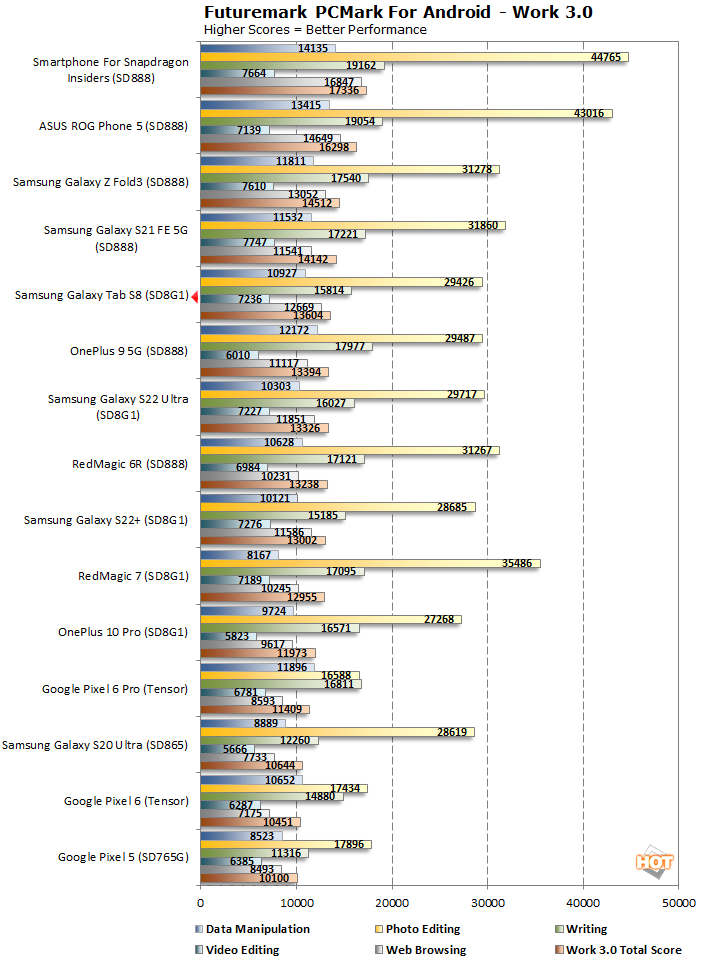
Here the Tab S8 gives us the best performance we’ve seen yet from a Snapdragon 8 Gen 1 equipped device, landing among previous generation flagship devices.
Samsung Galaxy Tab S8 AnTuTu 8 Benchmark Results
AnTuTu’s latest benchmark returns a number of metrics ranked with somewhat nebulous scores, rather than frame rates or time to complete. Here we're running the latest version of AnTuTu across multiple Android devices. AnTuTu returns four top level performance results which are all included here: CPU, RAM, 3D, UX (or User Experience), along with a total score…
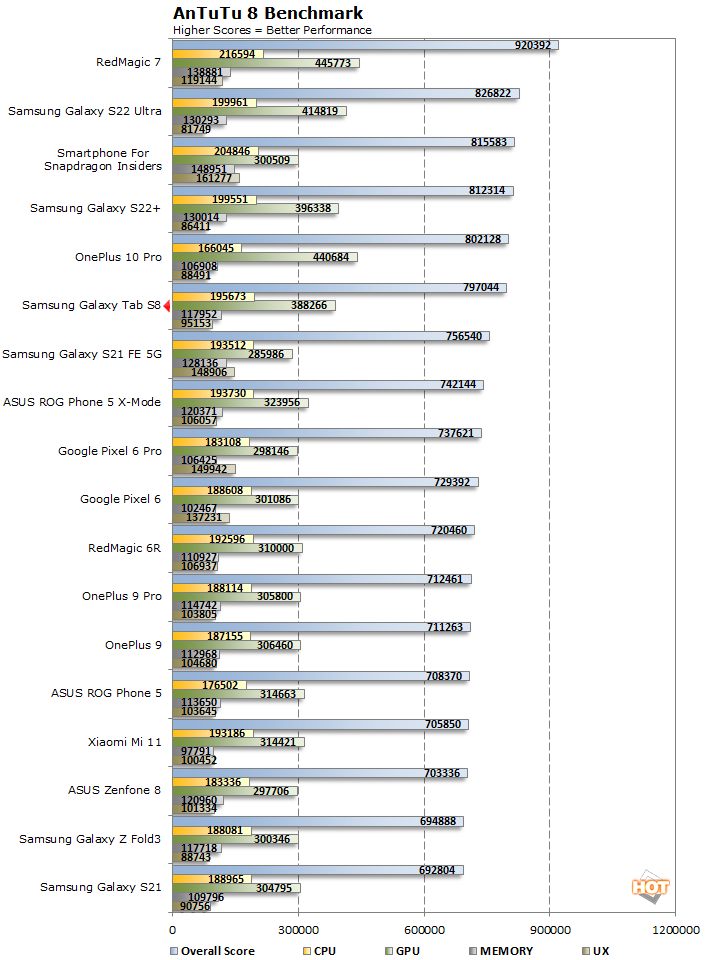
While the Tab S8 lands under the OnePlus 10 Pro when ranked by overall score, the tablet tops the phone in the CPU, UX, and memory categories.
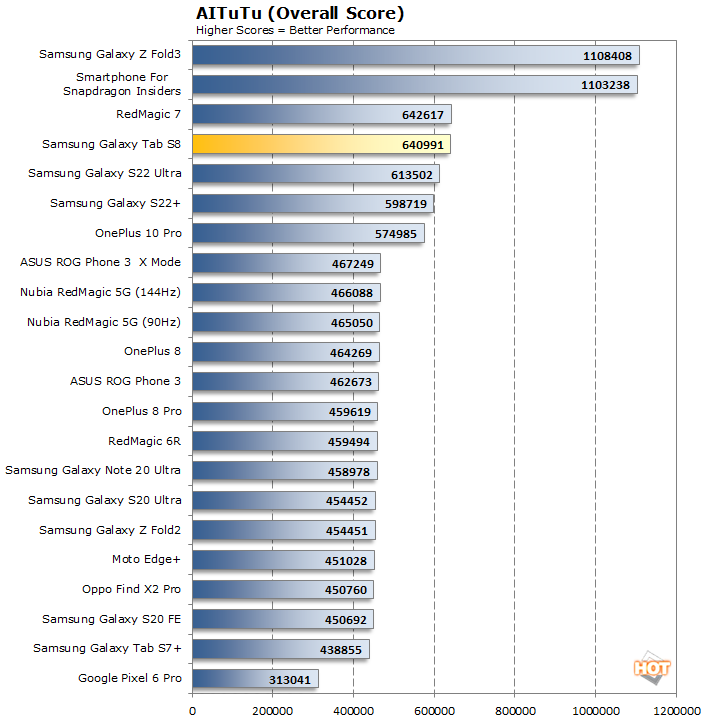
The Tab S8 sees a significant improvement over the Tab S7+ in AiTuTu, which tests machine learning workloads, specifically image classification and object detection. The Tab S8 lands right under the RedMagic 7, but just like the other Snapdragon 8 Gen 1 devices we’ve tested, the Tab S8 doesn't catch two scores in our database from devices equipped with the previous generation Snapdragon 888. We've found this to be the case where some devices might not have the latest neural network models installed in the device’s firmware packages, so an update from Samsung could easily change this picture.
3D Graphics And Gaming Benchmarks With The Samsung Galaxy Tab S8
Next we're checking how the Galaxy Tab S8 series compares in GFXBench, which has been one of the standard mobile graphics/gaming performance benchmarks for years. To ensure that display refresh (v-sync) and resolution aren't limiting factors, we're comparing off-screen test results here. GFXBench tests OpenGL ES graphics workloads and we're specifically testing OpenGL ES 2.0 and 3.0.
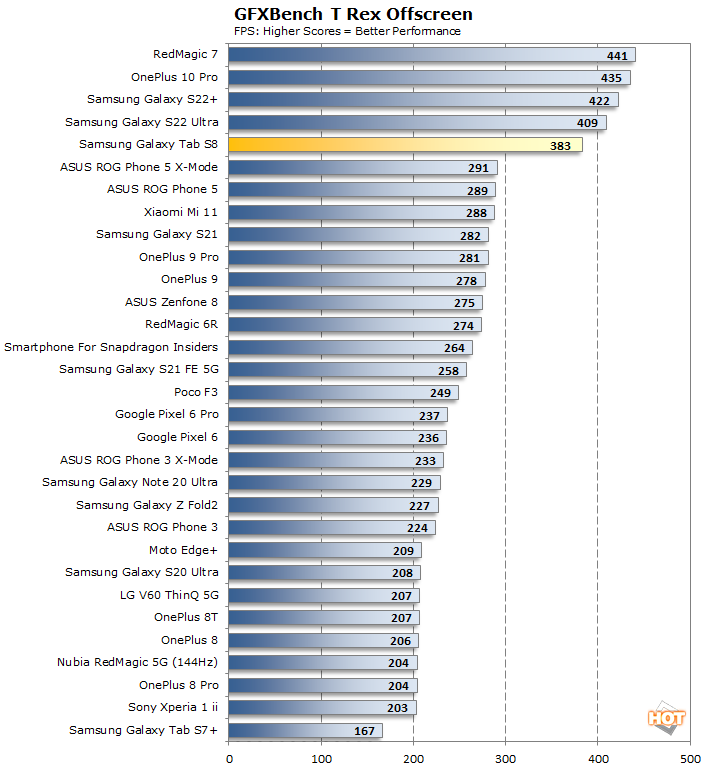
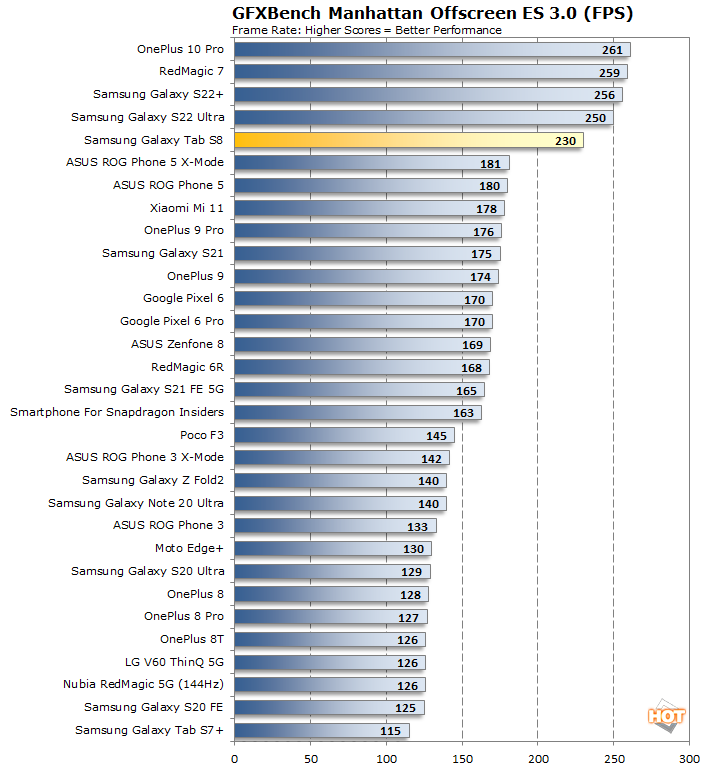
Here the Tab S8 sits at the bottom of the Snapdragon 8 Gen 1 grouping, but still scores significantly higher than last generation devices and doubles our Tab S7+ scores.
Futuremark's 3DMark Sling Shot is a newer benchmark module that's been added to the 3DMark mobile suite. Unlike previous gen 3DMark mobile tests, Sling Shot is a much more advanced OpenGL ES 3.1 and Metal API-based benchmark that employs more advanced rendering techniques, like volumetric lighting, particle illumination, multiple render targets, instanced rendering, uniform buffers and transform feedback.

We're running this test in off-screen mode once again to remove display resolution differences from the equation. This lets us compare cross-platform results more reliably…

We rank these results by overall score, which places the Tab S8 among a mix of Snapdragon 8 Gen 1 and Snapdragon 888 devices. However, the Snapdragon 8 Gen 1 consistently produces significantly higher graphics scores than the prior gen SoC, and the Tab S8 has the third highest graphics score we’ve recorded so far.
Samsung Galaxy Tab S8 3DMark Wild Life Benchmark Tests
3DMark Wild Life is the latest cross-platform test from UL. Its primary purpose is to measure GPU performance across platforms, and two distinct tests are available. The standard Wild Life test is designed to give feedback on how a game performs over a short period of time. With mobile games, people typically play in brief spurts when they find some free time; be it on the bus, on the subway, or a quick battle royale session over lunch break. The 3DMark Wild Life Stress Test, on the other hand, shows how a device performs over a longer stretch of time, and takes note of performance degradation that might crop up due to increased heat levels and throttling.

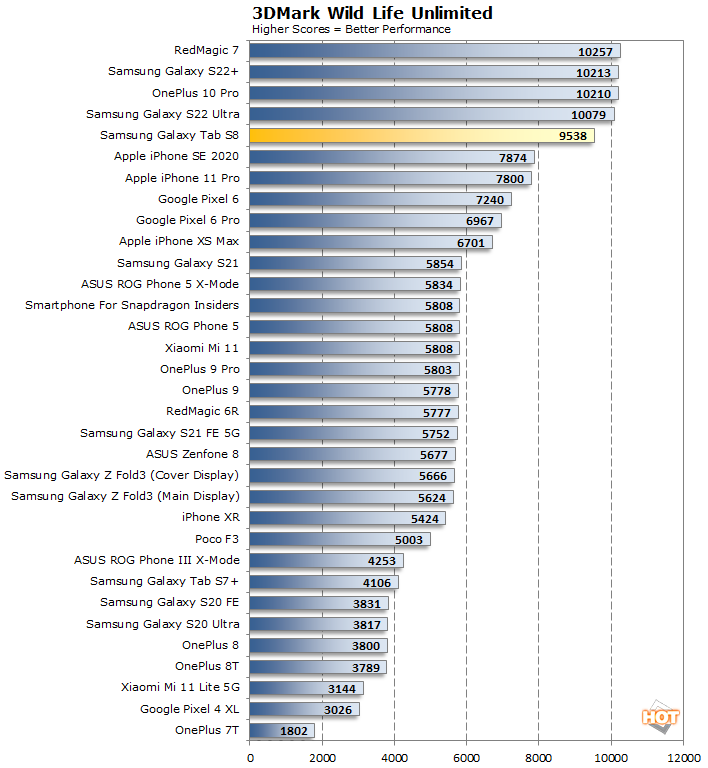
3DMark Wild Life is a significantly more taxing graphics benchmark that employs cutting-edge mobile game engine technologies to deliver impressive visuals -- as you can see in the screen shot above. As with the GFXBench tests, while the Tab S8 has the lowest score among Snapdragon 8 Gen 1 devices, it still stands apart from previous generation devices and more than doubles our Tab S7+ score.
The Elephant In The Performance Room: GOS Throttling
Before we look at the stress test results, there's a related controversy we should discuss. Samsung was recently the subject of some negative attention, particularly in the company’s home country of South Korea, where the Federal Trade Commission (FTC) received a formal complaint, regarding Samsung’s Game Optimizing Service (GOS). According to Samsung’s CEO, GOS throttles games in order to mitigate overheating. However, the initial allegations claimed that GOS was throttling all 10,000+ apps found in a list that included lots of non-gaming apps.
Contrary to the initial claims, the list actually provides GOS with information that it uses to determine whether to throttle an app or not. As the name would suggest, GOS throttles only games, as needed, and leaves other apps alone. Even so, Geekbench still delisted four generations of Galaxy phones and the Tab S8 series over “benchmark manipulation.” Benchmarks are generally intended to measure real-world performance, and by throttling games but not throttling benchmarks, GOS creates a performance discrepancy between real-world gaming performance and benchmark performance.
That said, the picture is somewhat more complicated than the accusation of benchmark manipulation makes it seem. Mobile SoCs, particularly Qualcomm’s Snapdragon 8 Gen 1, run hot under sustained load, which is a phenomenon we’ve noted over many reviews. The chip can perform impressively at peak power, but it can’t keep that up without getting hot in devices with sub-par cooling. Excepting gaming phones with extra cooling capacity, if you throw a performance-intensive workload at the Snapdragon 8 Gen 1, the device will have to start throttling the chip after a few minutes to keep the operating temperature within a reasonable, stable range.
GOS tries to preempt the throttling that occurs when you let the SoC run hot while gaming for an extended period. By throttling performance-intensive games from the start, GOS aims to produce more consistent gaming performance over extended gaming sessions, rather than leaving performance to fall off a cliff noticeably hard (like the iPhone 13 does, frankly). There’s no way to get around throttling the SoC in an ultra-compact mobile device with passive cooling. Samsung simply took a different, but understandable, approach to throttling with GOS. While benchmark performance on devices with GOS isn’t a good representation of real-world sustained gaming performance, the same can be said for most devices with mobile SoCs. Most benchmarks are short, so the chip doesn’t get hot enough to require throttling. However, in a real-world gaming setting, the chip will get hot and require throttling, so sustained real-world gaming performance will not always reflect benchmark gaming performance either. As such, Samsung hardly seems to be to blame for this performance discrepancy.
Nonetheless, this performance discrepancy applies only to sustained performance-intensive workloads. Beyond a subset of games, the vast majority of mobile workloads won’t tax the SoC for any significant length of time. Mobile SoCs are optimized for normal usage in mainstream, non-gaming specific devices, rather than for heavy gaming, so they’re good at upping performance in small bursts when necessary, rather than running at full power for sustained periods. Accordingly, GOS doesn’t throttle non-gaming apps, because the SoC doesn’t run hot enough under normal usage to require throttling.
Since GOS doesn’t throttle benchmarks, you can see in the 3DMark stress test the throttling that the Snapdragon 8 Gen 1 requires after undergoing sustained load. The only exceptions to this throttling are gaming phones. That said, we didn’t observe as much throttling with the Tab S8 as we’ve seen with many phones, likely due to the extra cooling capacity of the larger tablet form factor. As the stress test progressed, the gradual degradation in performance formed a more linear and shallow downward slope than the performance step down we’ve observed in phones, which appears more dramatic. The Tab S8 earned a performance stability score of 73%, which is very good when compared to the OnePlus 10 Pro’s 63.5% or the 49.8% and 52.5% of the Galaxy S22+ and S22 Ultra, respectively. Even so, the Tab S8’s stability score matches that of the iPhone 13 Pro, which doesn’t benefit from the larger tablet form factor and still outputs higher scores.
Galaxy Tab S8 PCMark Battery Life Test

The PCMark battery test loops the wide range of tasks that compose the regular PCMark Work 3.0 benchmark from 80% to 20% battery. Looking at the results, the Tab S8 makes pretty good use of its 8,000 mAh battery, given the tablet’s display resolution of 2560x1600, which is higher than most phones. We ran the test with the display locked to 60Hz, as well as with an adaptive refresh rate that varies between 60Hz and 120Hz in response to onscreen motion. During the adaptive refresh rate run, the display spent around half the test at 120Hz and the rest at 60Hz, excepting a short portion of the looped tasks where the FPS counter showed 96Hz. The adaptive refresh rate run lasted 13 hours and 10 minutes, while the 60Hz run lasted 15 hours and 37 minutes. We also ran the battery test with the tablet in DeX mode to see if DeX increases battery usage, but the results were nearly identical to our non-DeX results.
During our time with the Tab S8, we never felt limited by the battery life. The tablet never died on us, and we charged it up every few days or so when convenient. The Tab S8 supports 45W wired fast charging, which Samsung says fully charges the tablet in 82 minutes. Unfortunately, a power adapter doesn’t come in the box, so we had to use a 30W power brick that we had on hand. Even still, the battery charged plenty fast.

